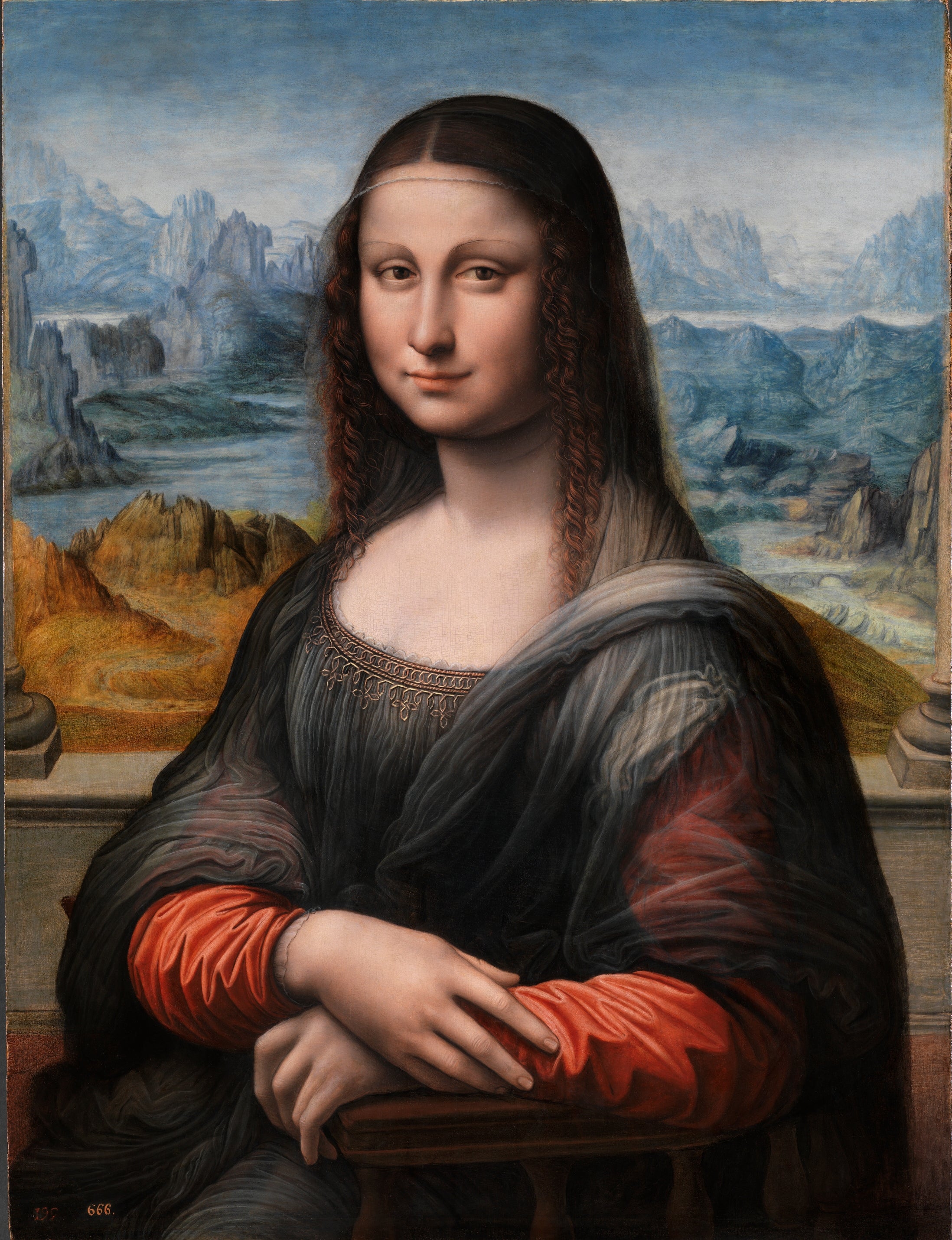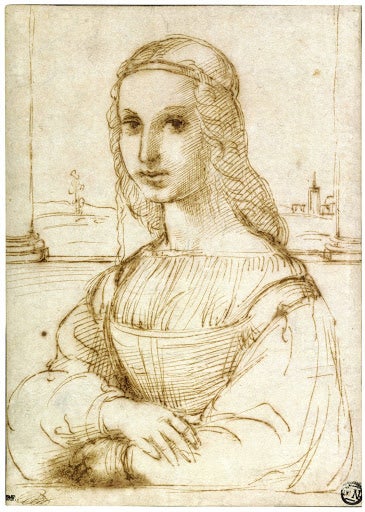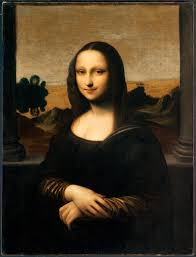Those sleeves are a bit of a shock. The whole thing is a shock - even if you know it’s coming. I first encountered this Mona Lisa downstairs at the Prado in Madrid a few years back, which is where I also picked up my fridge magnet. (I also have Las Meninas and a really brilliant El Greco - all told it’s quite a fridge coming together.) I knew she was there - that is, I knew the Prado had its own Mona Lisa - but when I turned the corner and there she was, I froze all the same. Everybody passing by seemed to freeze. You, here? A reminder, if any were necessary, that there is more than one Mona Lisa. This one is widely understood to be a copy from Leonardo’s workshop. No mystery here. But there are other Mona Lisas beyond the Prado’s, too. And from there it gets complicated. How complicated? I am not going to try and untangle it all here. This mystery - it is known as the Two-Mona Lisa Theory, and it’s been knocking around for centuries - is one of the great unsolvable questions of art. It’s muddled all the more, a riot of superpositions, because so many people think they have solved it in their own ways, and so many more think there is no mystery in the first place and we’re all just picking away at nothing. Today I’m just going to tell you about yet another Mona Lisa, and yet another another Mona Lisa. This last one was offered to me for sale a week back, in Animal Crossing. It’s always a great day when Redd turns up. I have kitted out my dinosaur museum now, and I’m simply not really bothered with the fish and the bugs. This means, I am ashamed to say, that my daily interaction with Animal Crossing now hangs by the slenderest of threads. It all hangs on Redd, who drops by about once a fortnight, to sell me old masters and the occasional fake. The old masters go in my art gallery, and there you’ll find the Mona Lisa - the real one, or rather the real one in Animal Crossing, the painting that has been given the okay by Blathers, the curator. Redd sold it to me a while ago, but every few weeks since he has returned and sometimes he tries to sell me another Mona Lisa. Very similar to the one I already have in Blathers’ gallery, but with one interesting distinction. This one has eyebrows. Close your eyes for a minute. Picture the Mona Lisa in the Louvre, smudged beneath that dirty yellowing varnish that the Louvre has decided never to remove, not because it might damage the painting, I gather, but because in our collective consciousness now, the Mona Lisa is this odd yellow-green thing, bottom of the pond, almost a bank note, really, or sticky on the wall of some old boozer. Anyway, picture the Mona Lisa. And tell me: does she have eyebrows? A good question. “If one wanted to see how faithfully art can imitate nature, one could readily perceive it from this head… The eyebrows were completely natural, growing thickly in one place and lightly in another and following the powers of the skin.” Who’s that? That’s Giorgio Vasari, the first art historian and a wonderfully gossipy, sometimes unreliable guide to the great artists of the Renaissance. Leonardo gets 17 pages in my copy of Vasari’s Lives of the Artists, which I nicked off my mum about a decade ago. He is writing about the Mona Lisa. He has seen the painting personally - at least that’s what you judge from the way he writes about it, three decades after the fact. And he can even tell you where the painting is at the time of writing: it’s in possession of King Francis of France, at Fontainebleau. One problem, though. Actually, a few problems. “He worked on this painting for four years, and then left it still unfinished,” Vasari tells us. This isn’t true of the Mona Lisa in the Louvre, which appears finished at least. (Granted, these things are always complicated with Leonardo, the patron saint of letting your tea go cold.) And, oh yes, the Mona Lisa in the Louvre doesn’t have any eyebrows at all. It is a noteworthy omission, you might say. Someone else saw the Mona Lisa back in the day - someone else who gets a write up in Vasari, incidentally. History suggests that Raphael saw the painting in Leonardo’s studio around the time Leonardo was allegedly still working on it - 1504. And Raphael drew a sketch of it. It’s a wonderful sketch, because Mona Lisa, the ultimate Leonardo, inevitably ends up looking a bit like a Raphael. Look at that chin! This sensation is only heightened because Raphael went on to paint a few women in very similar poses himself - and of course they all look like Raphaels too. The Raphael sketch is very neat and clear: it has the look of evidence. But wait. Two problems, one of them familiar: this Mona Lisa has eyebrows. And what’s with those columns? (Actually three problems, but I’ll mention the last one and then we can forget it because it’s even more way over my head than the rest of the stuff I’m talking about here: The third problem is that elements in the changing ways Leonardo handled paint suggest that the Louvre Mona Lisa was only painted a decade after 1504 when Raphael did his sketch - to put it another way, Leonardo tended not to paint like that back in the very early 1500s.) The Mona Lisa in the Louvre has neither eyebrows nor columns. The Mona Lisa in the Prado, which, again, is seen as being a copy created in Leonardo’s studio alongside the Louvre painting, and has as such been used for colour comparisons, does not have columns either - though it does have eyebrows. Nobody is saying Leonardo did the Prado painting: it was totally normal for a workshop to create multiple copies of the master’s work and it doesn’t really look like an actual Leonardo. But the matter of columns and eyebrows, both associated with Leonardo’s Mona Lisa in the historical record, and both being missing from the Louvre Mona Lisa, which is definitely by Leonardo, has confused people for a long time. Hence the theory that Leonardo painted two Mona Lisas. But if Leonardo did, and one’s in the Louvre, and the Prado copy can be discounted as an apprentice’s work, where’s the other genuine Leonardo? Oh, if only there was a Mona Lisa not by Raphael with both eyebrows and columns! Who’s this? This is the Mona Lisa, perhaps. And it’s Leonardo. Perhaps. Perhaps not. This painting is now called the Isleworth Mona Lisa, and it turned up in 1914. Reader: I love this painting. I think it is absolute magic. And look - it shows the sitter with a very familiar pose and clothes and face. But there are eyebrows and columns - and, a potential win for Vasari, the background seems unfinished. But a new mystery, as well: this Mona Lisa seems much younger than the Mona Lisa in the Louvre. Not the painting, but the person. A younger sitter, but also, somehow, very much the same sitter. I am going to stop here, because here is the point where the ground gives way. Suffice to say there are more than enough variables to power the theory that Leonardo painted two Mona Lisas, just as there is evidence, revealed through a process called the Layer Amplification Method by the inventor and physicist Pascal Cotte that the Mona Lisa in the Louvre has a younger Mona Lisa hidden beneath her in separate layers of paint (along with various other surprises - take a look at the extremely entertaining documentary below if you want to know more about this and the Two-Mona Lisa Theory in general). Some people think the Isleworth and the Louvre Mona Lisas are the two paintings. Some think that, because of Cotte’s separate layers, the Louvre Mona Lisa is both of the two paintings on one piece of wood. There are other candidates, and then some people also think the two-paintings stuff is bobbins. Onwards and outwards, this is how it is with art. Conjecture. Educated guesses. We know that the Louvre Mona Lisa was in Leonardo’s possession when he died. We don’t know why he kept it. Cotte found evidence that the Louvre Mona Lisa once had eyebrows, and suggests that they disappeared due to overcleaning. Beyond that, the columns, the dates, the intentions? Who knows? Leonardo is mysterious, Vasari is unreliable, history is not particularly good at taking care of objects and a painting is, ultimately, just another object. And that’s what I love about them, really. Of all the aspects of art history that seem to thrum with mystery, provenance is the one I love the most: who owned this painting, and then who owned it afterwards? Where did it go? Where did it hang? And, by extension, what did the people passing by think of it? There was a point, after all, at which the Mona Lisa went from being just a painting to being the painting, a point where it earned its bulletproof glass. Provenance! And, at every step of this process, contamination is possible. Facts get muddled. Names are swapped. Eyebrows get lost through overcleaning. I have probably added to contamination in my own tiny way with this hastily written and not particularly rigorously researched article. And Redd, working away in some Animal Crossing garret, observes the painting before him - a fraud, of course, but the wood is a good match and the varnish has a nice layer of craquelure to it. Fresh, no doubt, from his oven. He reaches for a brush: this famous face, there is something missing, no? Just above the eyes. Just above the eyes.



